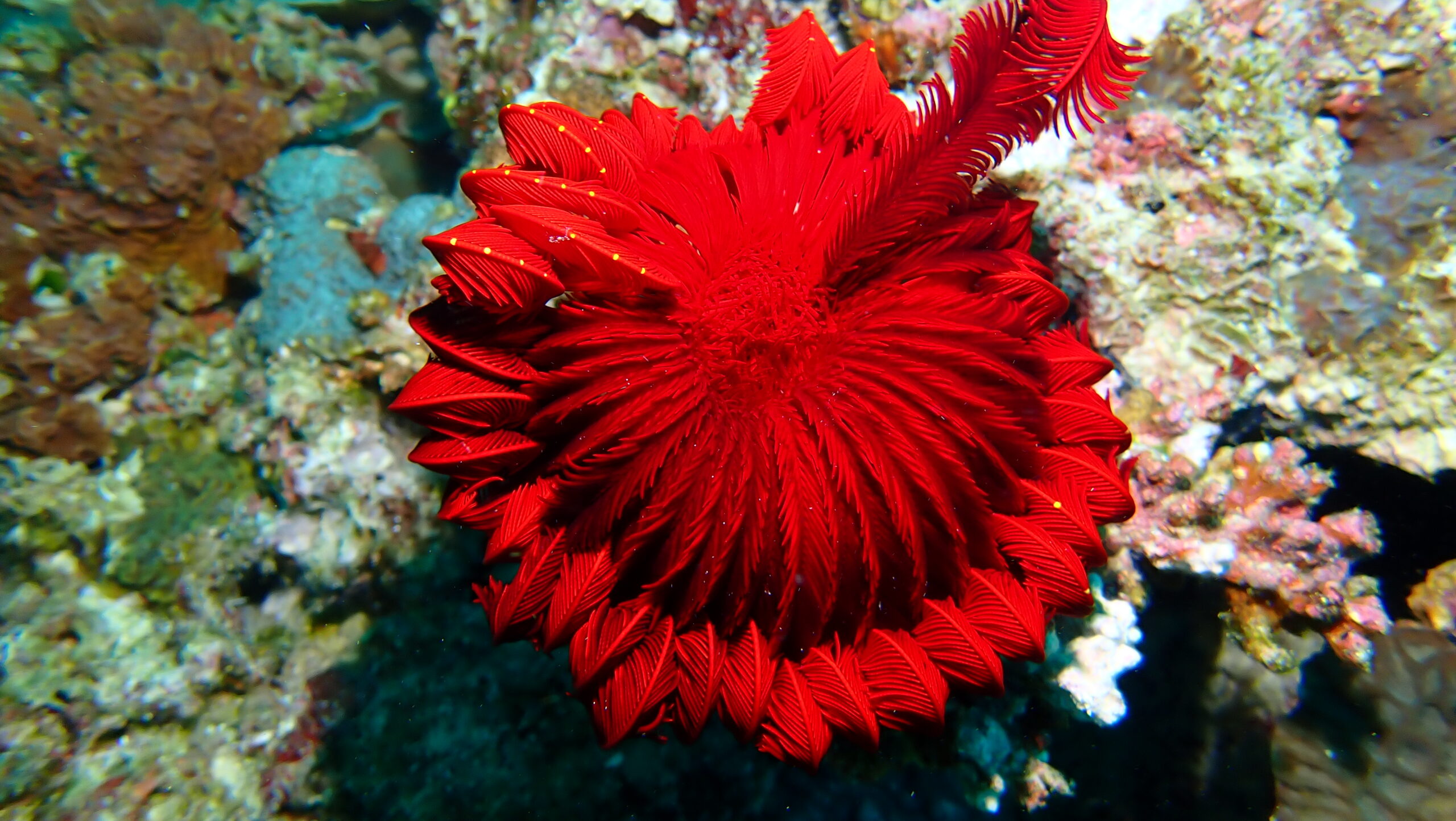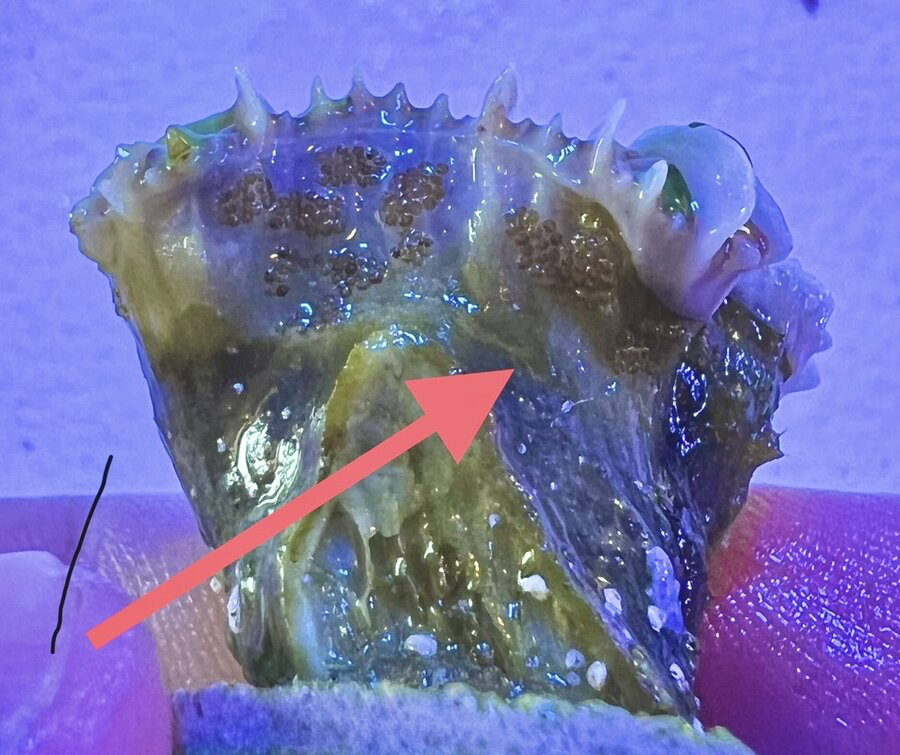Feather stars and sea lilies are echinoderms classified within Class Crinoidea. They easily capture the hearts of new and seasoned hobbyists alike, and find their way into home aquariums due to their beautiful outer appearance and the graceful way they swim, quite unlike any other creature.
While crinoids may be gorgeous and seem as if they would make the perfect centerpiece for an aquarium of suitable size, they very rarely thrive in captivity, and, while mortality rates have not been documented, there’s a reason they’re abundant in the ocean and common in fish stores, yet scarcely seen elsewhere.
Like many sea stars, there exists a feeding quandary that causes many specimens to succumb to starvation fairly quickly, in addition to the flow and space required for such delicate creatures which further complicates the meeting of their nutritional requirements.
Perhaps surprising to some, even many staff members at numerous stores that sell them possess little knowledge regarding their biology or even the species in stock. In order to avoid making an ill-advised purchase and later having no choice but to watch painfully while such a majestic creature slowly withers away, an understanding of why they fare so poorly in captivity is of great importance.
The habitats of crinoids range from the great depths of the oceans to the shallows of the reefs and they can be found worldwide, commonly in dense aggregations. Altogether, Class Crinoidea is composed of over 600 species, many of which are referred to simply as “feather stars” due to the great difficulty in identification of species and their pinnule appendages which lend their arms the appearance of feathers and enable them to swim in such an elegant manner.
Although there are species of crinoids with the inability to swim at all, commonly called “sea lilies”, they are not found in the hobby. Feather stars are a frequent sight of divers where they are abundantly found on most coral reefs and are no less beautiful when viewed in their natural habitat. After taking a dive into crinoid feeding biology and learning more about them, you, like many, may feel they belong in our oceans and only rarely in the aquarium trade.
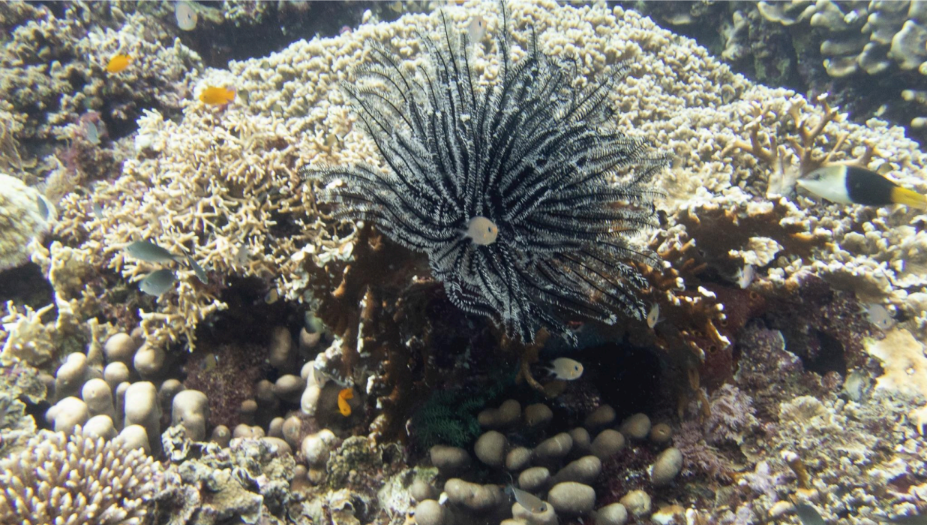
Location: Bohol, Philippines, Credit: Malcolm Levison
The Challenge of Species Identification
Within Class Crinoidea, Order Comatulida includes all 530 feather star species that detach from their postlarval stalk and become mobile (SUMMERS et al., 2017). These 530 species are broadly distributed and exhibit widely varying color patterns, may differ in the number of arms, and even show variability among other morphological characteristics due to environmental variations (SUMMERS et al., 2017).
This makes species identification quite a challenging task for most, except for the few researchers trained in crinoid taxonomy. The use of morphological characteristics for identification requires a firm grasp of crinoid biology involving anatomical terminology and the careful examination of many physical characteristics, making species identification a task that the average hobbyist or store employee is unable to accomplish without training.
The Dietary Dilemma
The primary issue at hand, aside from species identification, is meeting their dietary requirements. This has historically been a highly difficult task to accomplish in specimens housed in hobbyist aquariums, particularly so if the species in question is unknown.
While all known members of the class are epibenthic feeders, not only do individual species have varying dietary preferences and needs, but they are also somewhat selective in the size of suspended particles. What is currently understood regarding diet has been gathered from the examination of gut contents and feces of various species, which has been found to include protists, larvae of various invertebrates, inorganic grains, and tiny crustaceans such as small copepod species (Byrne et al., 2017).
At first thought it may seem as if they are generalists, and, therefore, nutrition would be unlikely to be the most prevalent issue leading to their high mortality. However, it’s important to bear in mind that the former list encompasses the entire class and it shouldn’t be assumed the (likely unknown) species for sale will acquire needed nutrition from the majority of the foods commonly available in the aquarium hobby.
Nor should it be assumed the maturity or size of an aquarium will ensure these finicky feeders have a suitable supply of food. Aquariums which are dominated by SPS corals sensitive to nutrients are particularly unlikely to support a thriving feather star due to lacking a constant supply of suspended particles in the water column.
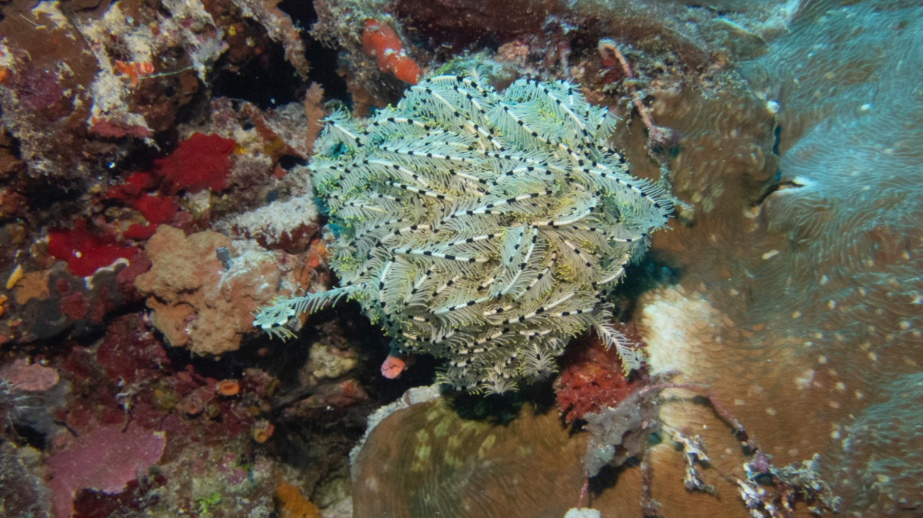
While there have been studies analyzing the gut contents and feces of numerous species for the determination of diet, there remain obstacles to applying the results of these studies to the maintenance of feather stars in captivity.
The first, and most obvious, is the aforementioned fact that taxonomy can be difficult and species that have been studied may have nutritional requirements that vary from those available for purchase.
Second, as feather stars are passive suspension feeders, dissimilarities in the constituents of fecal and gut contents are a result of variations in location and time (Lawrence, 1987). This creates uncertainty pertaining to what, precisely, it is they are actually acquiring nutrition from and to what extent each constituent of the gut contents contributes.

Size selectivity of particles may be relatively low, ranging from approximately 20µm to 150µm, and particles need only to be able to fit into the ambulacral groove in order to travel to the stomach. However, one study researching the feather star Antedon bifida found that only certain diatoms found in the gut were actually able to be digested and concluded that much of the detrital material was refractory (unable to be digested), with the associated microflora and microfauna serving as the major source of nutrition (La Touche & West, 1980).
Successes vs. Shortcomings
Although no statistics exist comparing the number of successful attempts in maintaining feather stars there are surely a few hobbyists who have, in fact, maintained crinoids and have had long and enjoyable experiences with them.
However, while the methods employed by these successful hobbyists may be replicated closely, the question as to what species was actually being maintained remains. Since species identification is such a formidable task, even if another hobbyist were to follow the precise feeding regimen, variations in the requirements of species such as sensitivity to parameters, for example, may present issues, the likelihood of which is uncertain.
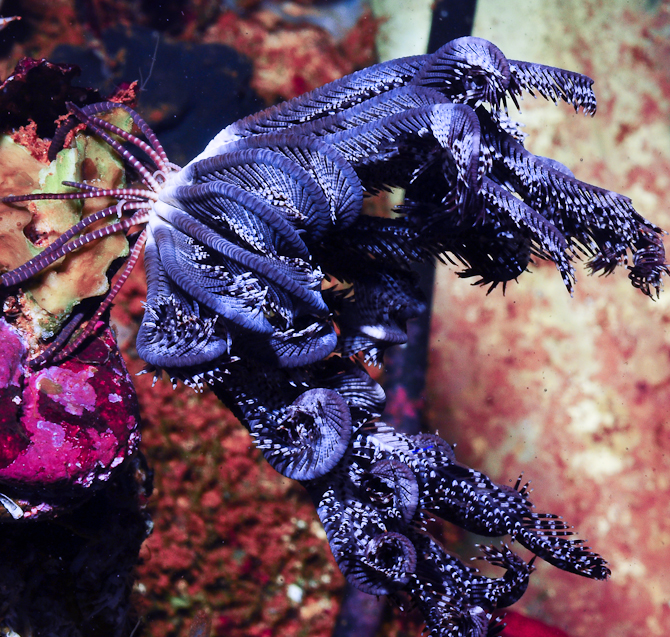
This is not to say that the few hobbyists who have maintained crinoids for a substantial amount of time aren’t successful. In fact, they’ve furthered our knowledge and given us clues as to what might be vitally important aspects of their proper husbandry. As is the case with maintaining all aquarium fish and invertebrates in the hobby, it must be remembered that one hobbyist’s successful experience certainly doesn’t guarantee the success of another.
For the Hobbyists Who Made the Purchase
For those who have already fallen victim to the beauty of these alien-like echinoderms and made a purchase, the first realization should be that a lot of work and regular monitoring of health will likely be required to maintain a healthy feather star.
Though the odds may not be high, there is always hope and the possibility that experimentation may even further our understanding of what is required to maintain them long-term. Due to the inability to generate currents or capture food actively, proper flow in a location which will likely deliver needed food should be prioritized.
The optimal strength of flow is dependent upon the species but gentle to moderate flow is most likely to replicate the natural currents many species would prefer in their natural habitat as closely as can be achieved in a home aquarium. Excessively strong flow rates should be fairly easy to detect as the feather star will choose to relocate and avoid the area.
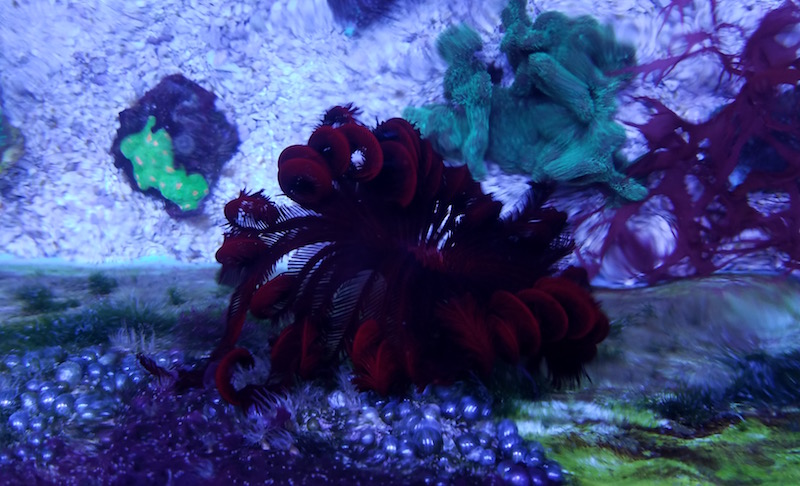
The next challenge is finding a suitable source of nutrition. Due to many phytoplankton species commonly dosed in the hobby, such as Nannochloropsis oculata, having too small a diameter to meet the documented size range of particles consumed and other common phytoplankton species being only slightly over the minimum size, a combination of live phytoplankton mixed with other foods such as Reef Nutrition’s Oyster-Feast (1-200 µm) or Benereef Benepets (3-3,000 µm) are likely to grant the greatest possibility of success.
The use of other foods that offer a broad range of particle sizes such as certain coral foods may also be of help. Though it may not be evident if the feather star in question is consuming or obtaining nutrition from a diet such as this, signs of poor health can be easily observed. Truly a sad sight to behold, if a specimen begins to decline in health due to malnutrition or starvation, the most obvious first sign is the shedding of arms. While they can regenerate lost arms in nature, this is rarely observed in captivity.
Should Crinoids Be Available In Abundance?
As is evident, feather stars are fragile creatures and with the current pool of knowledge we have to draw from regarding their nutritional requirements coupled with identification of species being extremely challenging, crinoids should simply not be common in the hobby at this point.
As our reefs are already in imminent danger and the need to reach a state of homeostasis is mandatory, we must remember that each marine organism fills a niche in the ecosystem. Therefore, to remove creatures with such a high mortality rate in captivity (and let’s not forget the supply chain) would be counterproductive.
Someday, perhaps even soon considering the rapid progression of captive breeding of echinoderms, hobbyists can experiment with new techniques and put novel ideas to the test. In fact, researchers developed a cultivation system that enabled the successful culture of the feather star Oxycomanthus japonicus over 15 years ago.
The culture method was so successful that they concluded enough embryos, larvae, juveniles, and adults could be cultivated for future experimentation and research (Shibata et al., 2008). However, until captive breeding of crinoids is further refined and affordable for aquaculture companies supplying the aquarium trade, or a firm understanding of their husbandry and other requirements to maintain them long-term in captivity has been achieved, let’s leave the majority of them on our reefs.
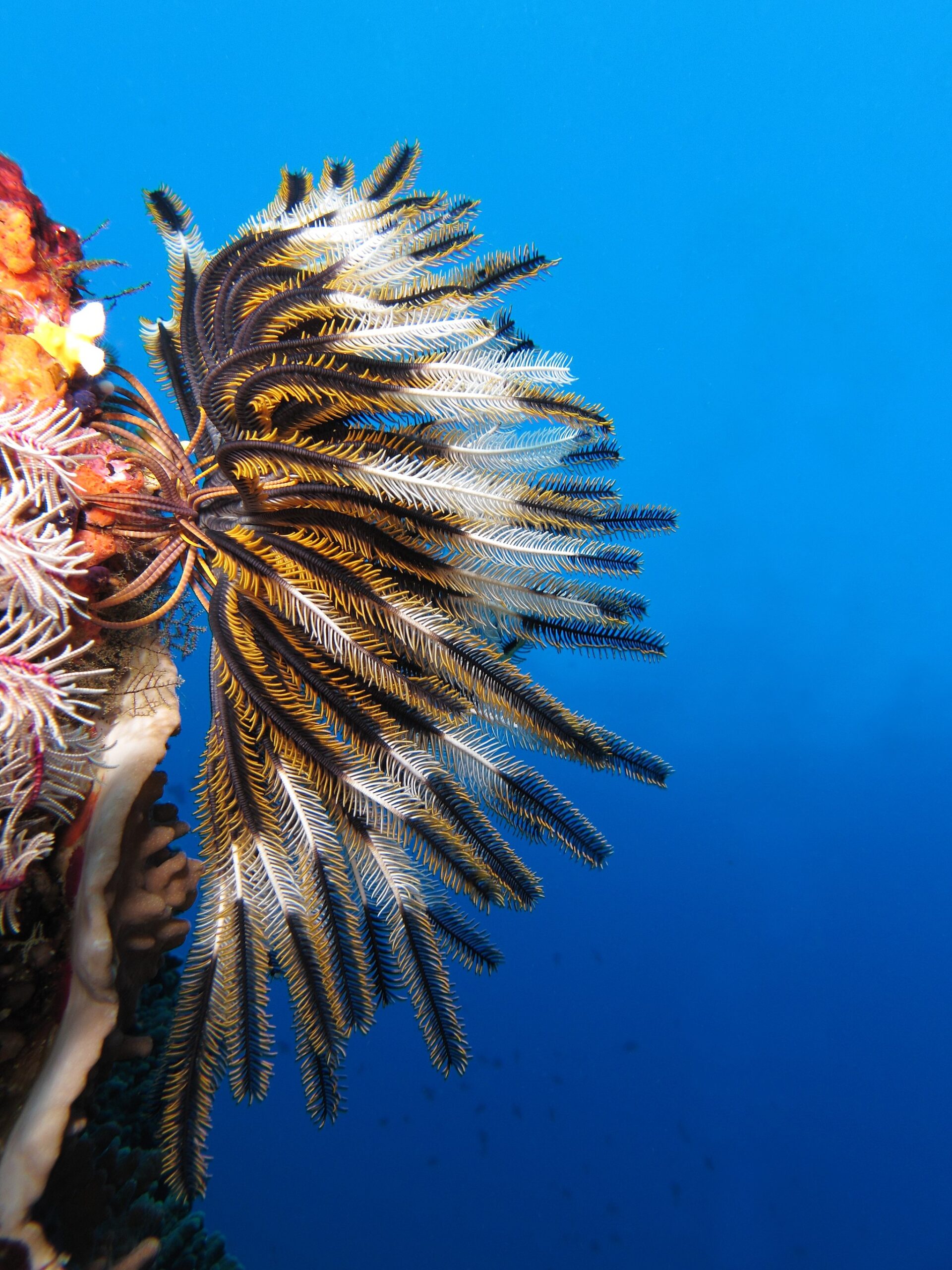
Glossary
Ambulacral groove – A groove running down the arms of crinoids that facilitates the transfer of food particles from the pinnules, where they are captured, to the mouth.
Main image credit Vadim Tokarev of Phuket Dive RU
References
Byrne, M., & O’Hara, T. (2017). Australian echinoderms: Biology, ecology and evolution. CSIRO Publishing ; Australian Biological Resources Study.
La Touche, R. W., & West, A. B. (1980). Observations on the food of Antedon Bifida (echinodermata: Crinoidea). Marine Biology, 60(1), 39–46.
https://doi.org/10.1007/bf00395604
Lawrence, J. (1987). A functional biology of echinoderms. Croom Helm.
Shibata, T. F., Sato, A., Oji, T., & Akasaka, K. (2008). Development and growth of the feather star Oxycomanthus japonicus to sexual maturity. Zoological Science, 25(11), 1075–1083. https://doi.org/10.2108/zsj.25.1075
SUMMERS, M. M., MESSING, C. G., & ROUSE, G. W. (2017). The genera and species of Comatulidae (Comatulida: Crinoidea): Taxonomic revisions and a molecular and morphological guide. Zootaxa, 4268(2).
https://doi.org/10.11646/zootaxa.4268.2.1
About the author
Malcolm Gray Levison is an avid diver, reef-keeping hobbyist, and dive photographer who takes great joy in sharing his experiences with others through his writing. He also possesses a true passion for studying the biology and ecology of coral reefs and desires to contribute to the conservation of these fragile ecosystems. www.youtube.com/@IntoTheBlueAndBeyond
